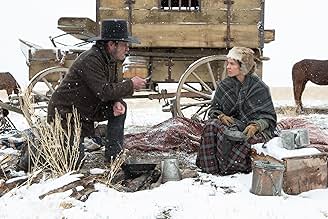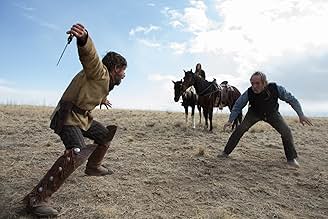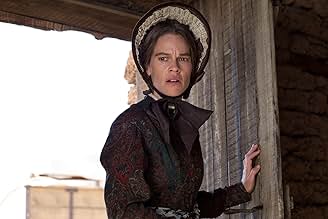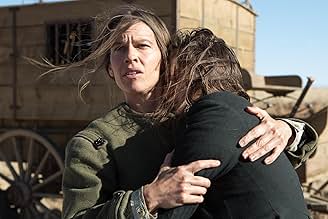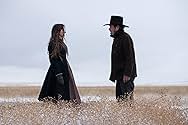अग्रणी जीवन से पागल होने वाली तीन महिलाओं को पवित्र, स्वतंत्र दिमाग वाली मैरी बी कुड्डी द्वारा कवर वैगन द्वारा देश भर में ले जाया जाना है।अग्रणी जीवन से पागल होने वाली तीन महिलाओं को पवित्र, स्वतंत्र दिमाग वाली मैरी बी कुड्डी द्वारा कवर वैगन द्वारा देश भर में ले जाया जाना है।अग्रणी जीवन से पागल होने वाली तीन महिलाओं को पवित्र, स्वतंत्र दिमाग वाली मैरी बी कुड्डी द्वारा कवर वैगन द्वारा देश भर में ले जाया जाना है।
- पुरस्कार
- 5 जीत और कुल 14 नामांकन
फ़ीचर्ड समीक्षाएं
The Homesman is a watchable film depicting the old west in a more true, and less glorious, fashion that most westerns. At first it is confusing, with flashbacks to explain the story, but later it becomes clear.
Prarie madness sets in and three women are slated to be returned Back East. The problem is that one of the three "responsible" men is unwilling to step up, so a woman volunteers. She is strong and courageous, more than most men, but isolated and desperate for a husband because she is "bossy, and plain as an old tin can."
Her ultimate fate is incongruous, completely at odds with her character. A willful suspension of disbelief is required at this point.
Solid performances by Swank, Jones, Lithgow, and the actress who played the madwomen make it entertaining, if a bit long.
Prarie madness sets in and three women are slated to be returned Back East. The problem is that one of the three "responsible" men is unwilling to step up, so a woman volunteers. She is strong and courageous, more than most men, but isolated and desperate for a husband because she is "bossy, and plain as an old tin can."
Her ultimate fate is incongruous, completely at odds with her character. A willful suspension of disbelief is required at this point.
Solid performances by Swank, Jones, Lithgow, and the actress who played the madwomen make it entertaining, if a bit long.
I enjoy a good western but it would not be fair to this Tommy Lee Jones production to classify it as such without emphasizing the film is more than just a wagon trail journey of two unlikely characters across the rough and unforgiving western terrain. No, it is the story of two unlikely characters, a single and strong willed farmer named Mary Bee Cuddy played by Hilary Swank and a thieving drifter named George Briggs played by Tommy Lee Jones who agree to transport three women by wagon with real psychiatric (madness) problems from Nebraska to Idaho.
There have been hundreds of relatively good westerns produced in the past half century where the hero and heroine remain strong and stoic whilst riding through the barren lands their suits and dresses remain pressed and in pristine condition while their hair is coiffed perfectly, and miraculously the heroine's makeup never dries, cracks or runs. Well such is not the case in the Homesman.
Hilary Swank has never been afraid to shed the glamor of Hollywood and for her role as the stubborn, single, and capable farmer Mary Bee Cuddy the potential suitors that she asks to marry her turn her down and explain that she is far too plain looking, sexless, and too controlling in nature. So Mary Bee Cuddy agrees to make the arduous journey across the western plains maybe in the hope of finding a suitor in Idaho as she has run out of potential suitors in Nebraska and seems to be losing hope in raising a family on her own farm in Nebraska.
As Mary Bee Cuddy commences her journey she comes across someone even more homely and desperate than herself in the name of aging drifter George Briggs who is within minutes of losing his life at the end of a rope for illegally claiming mining rights to another persons staked property. The terms set forth by Mary Bee Cuddy before she will agree to free George Briggs from his futile situation and imminent death by hanging are simple. He must first agree to travel across the western plains of Nebraska to assist Mary Bee Cuddy in the transportation of three insane women to a church in Idaho where they will receive the care and attention they will require to survive.
And so the two hardened caretakers and their three insane passengers set out on their journey which I found to be not like any other western I had previously seen. This is not a humorous and light hearted western but a tough, grueling, and sad journey with what I was surprised provided unexpected results. Some people may not be happy with the last 30 minutes of this feature film, but this is actually where writer/actor/director Tommy Lee Jones hooked me with what I felt was a good feature film that ended strongly.
There are numerous cameos throughout the film including standout performances by Tim Blake Nelson as a lonesome cowboy, John Lithgow as Reverend Dowd, and Jesse Plemons as a derelict husband to one of the insane women. Look for mother Meryl Streep in Idaho as the Reverends wife Altha Carter who enjoys sharing the screen with her real life daughter Grace Gummer who plays one of the three insane women Arabella Sours.
I give the film a good 7 out of 10 rating.
There have been hundreds of relatively good westerns produced in the past half century where the hero and heroine remain strong and stoic whilst riding through the barren lands their suits and dresses remain pressed and in pristine condition while their hair is coiffed perfectly, and miraculously the heroine's makeup never dries, cracks or runs. Well such is not the case in the Homesman.
Hilary Swank has never been afraid to shed the glamor of Hollywood and for her role as the stubborn, single, and capable farmer Mary Bee Cuddy the potential suitors that she asks to marry her turn her down and explain that she is far too plain looking, sexless, and too controlling in nature. So Mary Bee Cuddy agrees to make the arduous journey across the western plains maybe in the hope of finding a suitor in Idaho as she has run out of potential suitors in Nebraska and seems to be losing hope in raising a family on her own farm in Nebraska.
As Mary Bee Cuddy commences her journey she comes across someone even more homely and desperate than herself in the name of aging drifter George Briggs who is within minutes of losing his life at the end of a rope for illegally claiming mining rights to another persons staked property. The terms set forth by Mary Bee Cuddy before she will agree to free George Briggs from his futile situation and imminent death by hanging are simple. He must first agree to travel across the western plains of Nebraska to assist Mary Bee Cuddy in the transportation of three insane women to a church in Idaho where they will receive the care and attention they will require to survive.
And so the two hardened caretakers and their three insane passengers set out on their journey which I found to be not like any other western I had previously seen. This is not a humorous and light hearted western but a tough, grueling, and sad journey with what I was surprised provided unexpected results. Some people may not be happy with the last 30 minutes of this feature film, but this is actually where writer/actor/director Tommy Lee Jones hooked me with what I felt was a good feature film that ended strongly.
There are numerous cameos throughout the film including standout performances by Tim Blake Nelson as a lonesome cowboy, John Lithgow as Reverend Dowd, and Jesse Plemons as a derelict husband to one of the insane women. Look for mother Meryl Streep in Idaho as the Reverends wife Altha Carter who enjoys sharing the screen with her real life daughter Grace Gummer who plays one of the three insane women Arabella Sours.
I give the film a good 7 out of 10 rating.
I need to get something off my chest: I'm not a fan of Tommy Lee Jones. I find him limited in range, much the same in most roles and, worst of all, he inexplicably won the Best Supporting Actor Oscar for The Fugitive, thus depriving Pete Postlethwaite for In the Name of the Father, Leonardo Di Caprio for What's Eating Gilbert Grape and Ralph Fiennes for his performance of pure evil as Amon Goeth in Schindler's List. In modern parlance, WTF?
But periodically, just occasionally, once in a while, he inhabits the screen in a manner that forces one to reconsider one's judgment. And so it is with The Homesman.
The Homesman is something of a surprise, and not just because Tommy Lee Jones is on remarkable form in it. Beyond a fine performance, the man writes, directs and co-produces it. Hell's bells, when did he become so damn good at everything?
In the bad old days of the pioneers in the Wild West, Mary Bee Cuddy (Hilary Swank) steps in when three women drift into various states of madness and need to be transported across the country to be cared for properly. Shunned by their husbands, denied help from the town's menfolk and at a time where rape and murder hides behind every outcrop of rock and every gnarled cactus, Cuddy sets off alone on her hazardous journey. She stumbles across George Briggs (Tommy Lee Jones), a drifter seated atop his horse, with a noose around his neck, waiting for his steed to grow bored and leave him hanging. Literally. Cuddy offers to save him on the condition that he accompanies her and so begins a particular kind of journey.
The Homesman is probably described by many as a western, but that's lazy. This is a road movie on horseback, a saunter across the plains, a journey through mistrust and emotions where a mistake or misplaced trust will result in death. It is a story of hope and love, not the romantic kind, but real love for one's fellow human being, regardless of whether they can, or will, reciprocate.
Shot beautifully with sprawling, dusty vistas that warm the heart and prickle the nape, the backdrop is a vast canvas of character and mystery upon which splashes of colour are smeared in the shape of wandering, human dangers.
Though they say little, the trio of women (Grace Gummer, Miranda Otto and Sonja Richter) are far more than peripheral characters or the MacGuffin; they are the substance that binds The Homesman and the reason for the drama, gentle though it is. As we saw in Mr. Turner, such characters can so easily become pantomime animals with over performance that slaps the viewer in the face and detracts from the whole, of which they are but a small part. Not so here. Grace Gummer, particularly, as the mostly mute but vacantly animated Arabella is terrific and we want to reach into the screen and gently push her back towards sanity. It is a beautiful, understated performance that remains in mind long after the event.
Tommy Lee Jones and Hilary Swank make a surprising double act but the chemistry is there in abundance. Both Cuddy and Briggs carry their own needs and daemons with them; neither would give the other a second glance ordinarily but circumstance prompts odd, emotional couplings and theirs is fraught with suspicion and obligation. It is fantastic to see Swank back to the form that brought her gongs and made us sit up and watch in Boys Don't Cry and Million Dollar Baby. This is a far less demonstrative performance, but no less steely or impactful because of it.
Tommy Lee Jones's performance is the most compelling, engrossing that I can recall. Beyond that, his direction is worth celebrating loudly. The Homesman is only his second feature as director (after 2006's wonderful but little seen The Three Burials of Melquiades Estrada) but there are hints that he may step into Clint Eastwood's shoes alongside Ben Affleck and Sean Penn. Just when we think we have the measure of this tale, he belts us sharply around the jowls, proving he has the mettle to surprise and shock us out of our complacency.
Maybe, after years and years of apparently coasting, broodily on film and staring into space, it will transpire he was merely absorbing, waiting for the moment to own both sides of the screen and captivate us.
You know what, maybe he's always been this good but I just didn't see it.
For more reviews from The Squiss, subscribe to my blog and like the Facebook page.
But periodically, just occasionally, once in a while, he inhabits the screen in a manner that forces one to reconsider one's judgment. And so it is with The Homesman.
The Homesman is something of a surprise, and not just because Tommy Lee Jones is on remarkable form in it. Beyond a fine performance, the man writes, directs and co-produces it. Hell's bells, when did he become so damn good at everything?
In the bad old days of the pioneers in the Wild West, Mary Bee Cuddy (Hilary Swank) steps in when three women drift into various states of madness and need to be transported across the country to be cared for properly. Shunned by their husbands, denied help from the town's menfolk and at a time where rape and murder hides behind every outcrop of rock and every gnarled cactus, Cuddy sets off alone on her hazardous journey. She stumbles across George Briggs (Tommy Lee Jones), a drifter seated atop his horse, with a noose around his neck, waiting for his steed to grow bored and leave him hanging. Literally. Cuddy offers to save him on the condition that he accompanies her and so begins a particular kind of journey.
The Homesman is probably described by many as a western, but that's lazy. This is a road movie on horseback, a saunter across the plains, a journey through mistrust and emotions where a mistake or misplaced trust will result in death. It is a story of hope and love, not the romantic kind, but real love for one's fellow human being, regardless of whether they can, or will, reciprocate.
Shot beautifully with sprawling, dusty vistas that warm the heart and prickle the nape, the backdrop is a vast canvas of character and mystery upon which splashes of colour are smeared in the shape of wandering, human dangers.
Though they say little, the trio of women (Grace Gummer, Miranda Otto and Sonja Richter) are far more than peripheral characters or the MacGuffin; they are the substance that binds The Homesman and the reason for the drama, gentle though it is. As we saw in Mr. Turner, such characters can so easily become pantomime animals with over performance that slaps the viewer in the face and detracts from the whole, of which they are but a small part. Not so here. Grace Gummer, particularly, as the mostly mute but vacantly animated Arabella is terrific and we want to reach into the screen and gently push her back towards sanity. It is a beautiful, understated performance that remains in mind long after the event.
Tommy Lee Jones and Hilary Swank make a surprising double act but the chemistry is there in abundance. Both Cuddy and Briggs carry their own needs and daemons with them; neither would give the other a second glance ordinarily but circumstance prompts odd, emotional couplings and theirs is fraught with suspicion and obligation. It is fantastic to see Swank back to the form that brought her gongs and made us sit up and watch in Boys Don't Cry and Million Dollar Baby. This is a far less demonstrative performance, but no less steely or impactful because of it.
Tommy Lee Jones's performance is the most compelling, engrossing that I can recall. Beyond that, his direction is worth celebrating loudly. The Homesman is only his second feature as director (after 2006's wonderful but little seen The Three Burials of Melquiades Estrada) but there are hints that he may step into Clint Eastwood's shoes alongside Ben Affleck and Sean Penn. Just when we think we have the measure of this tale, he belts us sharply around the jowls, proving he has the mettle to surprise and shock us out of our complacency.
Maybe, after years and years of apparently coasting, broodily on film and staring into space, it will transpire he was merely absorbing, waiting for the moment to own both sides of the screen and captivate us.
You know what, maybe he's always been this good but I just didn't see it.
For more reviews from The Squiss, subscribe to my blog and like the Facebook page.
The Homesman, about a 31 year old (un-married/childless) woman (Hilary Swank) who takes up the challenge of bringing three crazed women across the Nebraska plains over five weeks with the help of a deserter-drifter left for dead (Jones), is in some ways meant to be a real Feminist Western (with a capital 'F'), and not in the way that a silly work like The Quick and the Dead was with Sharon Stone. Here, it's much more about depicting a time and place that was quite bleak and desolate and, in some spaces, without much hope. Ultimately Tommy Lee Jones, through the novel it's based on, sees a little more light at the end of the tunnel for his protagonist than, say, Eastwood did in Unforgiven. But it's a combination of things it's about, and emotionally the film does work quite well, in particular in the relationship that unfolds between the two leads.
If you're curious to see a western that has the love of the plains of the West visually speaking ala Ford, but has the dark contours of someone like Mann - and added to that those super dirty production designs and character realizations from Spaghetti Westerns - this might be it, at least up to a point. It's so unrelentingly dark in how it looks on at the deteriorating mental states of these women, and the desperation in the journey for Jones and Swanks' characters, that the few moments of humor are rather surprising - and welcome - especially when Jones first appears to Swank on the noose and the horse. It's the kind of scene that shows this actor, well into his 60's and pushing 70, trying something new in a performance (if only for a scene or two).
It's got a cast that is practically distracting for the who's who that shows up, mostly for one scene a piece: James Spader, Tim Blake Nelson, John Lithgow, William Fichtner, Meryl Streep (!) and Hailee Steinfeld (who appears almost to have wandered from the True Grit set to this one). There's so much going for the Homesman that it's a shame the script is uneven, and there's a plot twist two thirds of the way through that is sort of explained but not at all at the same time, and it leaves the film with a gaping tragedy that can never quite be filled. Interestingly, if you watch the behind the scenes on the blu-ray one of the screenwriters mentions the book left things unexplained as well. That might be fine in the book - or perhaps more was explained in other ways - but it still doesn't work, and what Jones goes for in awe-inspiring shots he leaves behind with some muddled story beats.
Nevertheless, The Homesman is a good Western, a solid western digging into the roots of the genre and mixing the unsavory and horrifying (not like a horror movie, just some repellant images at times, but for a point), though whether one will want to return to it like other, better Westerns is another story. It's the kind of picture I can't put down for its artistry, even if things can be looked at more critically, which may explain why it didn't find its way through the End-of-Awards-time (albeit it was accepted at Cannes).
If you're curious to see a western that has the love of the plains of the West visually speaking ala Ford, but has the dark contours of someone like Mann - and added to that those super dirty production designs and character realizations from Spaghetti Westerns - this might be it, at least up to a point. It's so unrelentingly dark in how it looks on at the deteriorating mental states of these women, and the desperation in the journey for Jones and Swanks' characters, that the few moments of humor are rather surprising - and welcome - especially when Jones first appears to Swank on the noose and the horse. It's the kind of scene that shows this actor, well into his 60's and pushing 70, trying something new in a performance (if only for a scene or two).
It's got a cast that is practically distracting for the who's who that shows up, mostly for one scene a piece: James Spader, Tim Blake Nelson, John Lithgow, William Fichtner, Meryl Streep (!) and Hailee Steinfeld (who appears almost to have wandered from the True Grit set to this one). There's so much going for the Homesman that it's a shame the script is uneven, and there's a plot twist two thirds of the way through that is sort of explained but not at all at the same time, and it leaves the film with a gaping tragedy that can never quite be filled. Interestingly, if you watch the behind the scenes on the blu-ray one of the screenwriters mentions the book left things unexplained as well. That might be fine in the book - or perhaps more was explained in other ways - but it still doesn't work, and what Jones goes for in awe-inspiring shots he leaves behind with some muddled story beats.
Nevertheless, The Homesman is a good Western, a solid western digging into the roots of the genre and mixing the unsavory and horrifying (not like a horror movie, just some repellant images at times, but for a point), though whether one will want to return to it like other, better Westerns is another story. It's the kind of picture I can't put down for its artistry, even if things can be looked at more critically, which may explain why it didn't find its way through the End-of-Awards-time (albeit it was accepted at Cannes).
The Homesman, written and directed and starring Tommy Lee Jones tells the story of Mary Bee Cuddy (Hilary Swank) a spinster who takes on the responsibility of bringing three insane women to Iowa where they can be taken care of.
She saves or spares the life of George Briggs (Tommy Lee Jones) and enlists him on her arduous five week journey.
When you see Hilary Swank and Tommy Lee Jones, you know the acting is going to be stellar. The parts of the insane women, Arabella Sours (Grace Gummer), Theoline Belknapp (Miranda Otto), Gro Svendsen (Sonja Richter) because of the great directing remained the focus while being secondary characters. The movie had a Shakespearean feel to it and that is a great compliment. These ladies portrayed insanity, believably and that takes serious dedication and acting ability.
"The Homesman" was a tragedy and because of it, some people might not be able to pallet the story; there were some shocking attention grabbing scenes that the average viewer might not be prepared for. Those scenes, to me, were great examples of a different time, a time when life was hard and people died.
The Homesman is a story that sits with you and makes you thankful for many things, even if it just the shoes on your feet.
She saves or spares the life of George Briggs (Tommy Lee Jones) and enlists him on her arduous five week journey.
When you see Hilary Swank and Tommy Lee Jones, you know the acting is going to be stellar. The parts of the insane women, Arabella Sours (Grace Gummer), Theoline Belknapp (Miranda Otto), Gro Svendsen (Sonja Richter) because of the great directing remained the focus while being secondary characters. The movie had a Shakespearean feel to it and that is a great compliment. These ladies portrayed insanity, believably and that takes serious dedication and acting ability.
"The Homesman" was a tragedy and because of it, some people might not be able to pallet the story; there were some shocking attention grabbing scenes that the average viewer might not be prepared for. Those scenes, to me, were great examples of a different time, a time when life was hard and people died.
The Homesman is a story that sits with you and makes you thankful for many things, even if it just the shoes on your feet.
क्या आपको पता है
- ट्रिवियाGlendon Swarthout's novel was published in 1988. Paul Newman owned the rights, and wanted to direct the film himself. After several failed scripts, he gave up.
- गूफ़During the Indian attack, every shot of the carriage has mountains in the background. The road from Nebraska to Iowa is nowhere near any mountains.
- भाव
George Briggs: Are you an angel?
Mary Bee Cuddy: You're not dead.
George Briggs: Help me. Will you help me? For God's sake.
- कनेक्शनFeatured in Film '72: 19 नवम्बर 2014 को प्रसारित एपिसोड (2014)
- साउंडट्रैकRosalie The Prairie Flower
Music & Lyrics by George Frederick Root (as George Fredrick Root)
Performed by Hilary Swank
टॉप पसंद
रेटिंग देने के लिए साइन-इन करें और वैयक्तिकृत सुझावों के लिए वॉचलिस्ट करें
- How long is The Homesman?Alexa द्वारा संचालित
विवरण
बॉक्स ऑफ़िस
- बजट
- $1,60,00,000(अनुमानित)
- US और कनाडा में सकल
- $24,29,989
- US और कनाडा में पहले सप्ताह में कुल कमाई
- $45,433
- 16 नव॰ 2014
- दुनिया भर में सकल
- $38,19,421
- चलने की अवधि2 घंटे 2 मिनट
- रंग
- ध्वनि मिश्रण
- पक्ष अनुपात
- 2.39 : 1
इस पेज में योगदान दें
किसी बदलाव का सुझाव दें या अनुपलब्ध कॉन्टेंट जोड़ें









